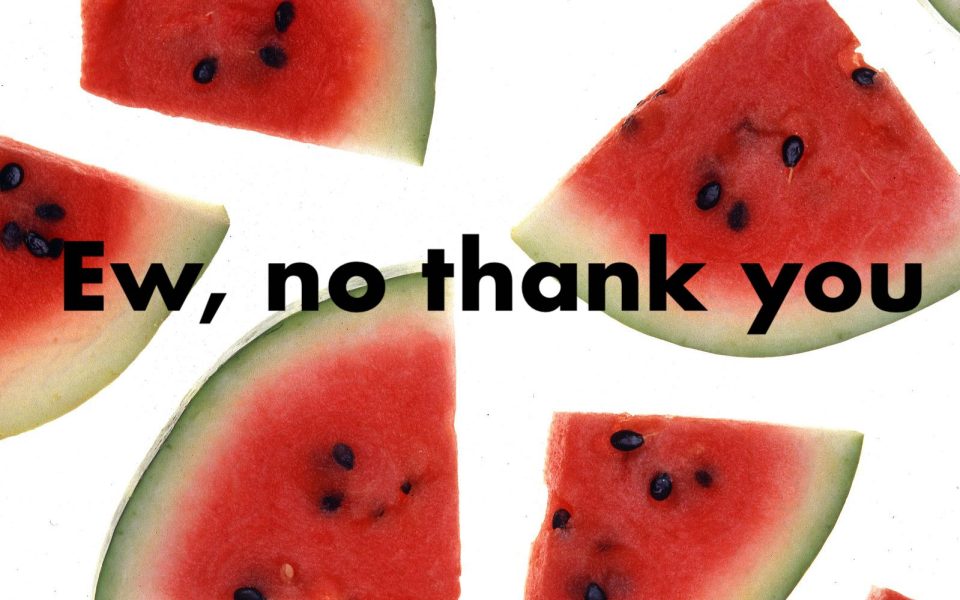I am a grown, Black woman who cannot stand to eat watermelon. And I don’t want to hear about it.
I don’t care for the scent, color or texture of the melon. Just the sight of the verdant rind sends me into a frenzy. With or without seeds, I derive no joy in munching on the juicy, crisp cubes of summer’s most succulent fruit.
I don’t remember the first time I had the fruit, but I do remember the last. Four years ago I was tasked with bringing snacks to the neighborhood pool to hang out with some friends and their children. Allergen-free foods were the only items allowed and that left nothing but hummus and fruit. I created melon skewers for the kids and soaked the rest in tequila and sprinkled it with homemade lime salt for the adults. The tequila changed the texture of the melon from grainy and watery to smooth and slick. The salt made the fruit tangy while the zest gave it zing. It made it better.

I understand that not everyone shares my hatred for the fruit. I understand that the ruby-red flesh (and in the case of some varieties, a golden yellow) is one of the most desirable parts of summer, for some even the personification of summer itself.
But not me.
If I liked watermelon, I’d put salt on it — iodized or kosher, liberally sprinkled on cut slices with reckless abandon. The contrast of the salt would somehow make the melon sweeter. And I’d save the rind for chopping and pickling — the sugar-and-salt solution renders the hearty rind palatable and looks good on charcuterie picnic spreads.
I’d make it upscale with the addition of briny feta-cheese crumbles, peppery leaves of arugula and drizzles of thick and dark aged balsamic vinegar. I would blend chunks into margaritas and milkshakes and make fruit salads more vibrant and diverse with the introduction of this melon into the bowl.
But I don’t do these things. Because I don’t like watermelon.
Culinary uses aside, the watermelon has a varied history and mixed connotation in America. No fruit, with the exception of the apple Eve got blamed for consuming, has been infused with such negative overtones.
Watermelon once symbolized self-sufficiency among African Americans newly freed under the guise of the Emancipation Proclamation of 1863. Following emancipation, many Southern blacks grew and sold watermelons. The melons grew wild and free, became gigantic under the Southern sun, and it became a symbol of our freedom.
At the same time, as freed people entered the free-market economy as wage earners, it was not long before this type of entrepreneurship was seen by white people as a threat, and they turned the watermelon against us.
American media of the late 19th and early 20th centuries thrived on the idea that Black Americans had a pathological weakness for watermelon. The trope spread throughout the late 1860s and supported the post-emancipation argument that Black people were lazy watermelon-eaters.

So while for some the watermelon is the ultimate symbol of summer, rising temperatures and the freedom to enjoy outdoors unencumbered, others see the watermelon as a symbol of white supremacy with negative, historical connotations
But hey: Enjoy your watermelon.
How to pick a watermelon:
The goal is to pick the sweetest, most ripe melon in the bin at the store or the farmers market. The rind color should be fairly dark and dull but uniform overall, with a dull patina. Field spots are okay, but be sure the spot is orange. White spots are an indication of little to no flavor inside. Pick one that is heavy for its size and sounds solid when you thump it with your thumb and forefinger.
To try Nikki’s melon skewers recipe go here.
Join the First Amendment Society, a membership that goes directly to funding TCB‘s newsroom.
We believe that reporting can save the world.
The TCB First Amendment Society recognizes the vital role of a free, unfettered press with a bundling of local experiences designed to build community, and unique engagements with our newsroom that will help you understand, and shape, local journalism’s critical role in uplifting the people in our cities.
All revenue goes directly into the newsroom as reporters’ salaries and freelance commissions.


Leave a Reply